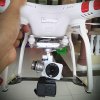I'm researching some potential additional markets to dip into and Agriculture is of great interest to me.
Until I can get a good feel for the viability of it in my area I'm not willing (or able) to invest in a dedicated Ag aircraft. While doing some research I ran across this statement and I'd like to know if anyone here can add anything to this or claim it's false. The below statement is in reference to using DJI (Phantom3 Advanced or Pro, Inspire or M100) platforms for Agriculture purposes.
"• Camera: The stock cameras on these drones work well. However, if you want to capture imagery that will generate NDVI and Variable Application Reports (variable rate application shape files), you will need to install an NIR filter in the camera. You will also need to modify the camera’s setting so it does not auto-adjust to changing light conditions during your survey."
Does anyone have experience with a reliable NIR filter for our Phantom3 A/P platform? Being able to do some advanced imaging from the stock aircraft camera would be SWEET but I'm afraid this is one of those things that's simply "too good to be true".
If you have any suggestions I'd love to hear more.
Until I can get a good feel for the viability of it in my area I'm not willing (or able) to invest in a dedicated Ag aircraft. While doing some research I ran across this statement and I'd like to know if anyone here can add anything to this or claim it's false. The below statement is in reference to using DJI (Phantom3 Advanced or Pro, Inspire or M100) platforms for Agriculture purposes.
"• Camera: The stock cameras on these drones work well. However, if you want to capture imagery that will generate NDVI and Variable Application Reports (variable rate application shape files), you will need to install an NIR filter in the camera. You will also need to modify the camera’s setting so it does not auto-adjust to changing light conditions during your survey."
Does anyone have experience with a reliable NIR filter for our Phantom3 A/P platform? Being able to do some advanced imaging from the stock aircraft camera would be SWEET but I'm afraid this is one of those things that's simply "too good to be true".
If you have any suggestions I'd love to hear more.






